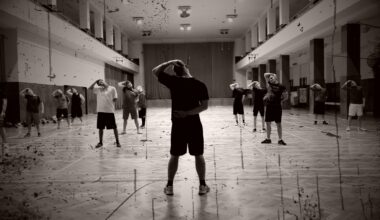Stretching Strategies for Diastasis Recti Recovery
Diastasis recti is a common condition that occurs during and after pregnancy when the abdominal muscles separate. Recovery from this condition requires targeted stretching strategies that gently strengthen and rehabilitate the core. One effective method involves focusing on the connective tissue and fascia that have been affected during pregnancy. Begin by consulting a healthcare professional to ensure proper diagnosis and treatment. Then, incorporate gentle stretches that promote flexibility and alignment. Consider a posture that keeps the pelvis in a neutral position while engaging the transverse abdominal muscles. It’s essential to avoid traditional abdominal exercises that risk further separation. Instead, try stretches like the cat-cow or pelvic tilts, which encourage proper alignment and abdominal engagement without excessive strain. Patience and consistency are key to seeing results. Aim to integrate these stretches into your daily routine. By nurturing your body’s healing process, you not only enhance core stability but also work towards improving your overall strength and posture. Stretching not only revitalizes the body but supports mental well-being, helping new mothers adapt to their changing physical state.
Finding a tailored routine for diastasis recti recovery involves a variety of gentle stretching exercises. One fundamental component of this is establishing a reliable foundation through consistent practices. Initiate your stretching regimen with gentle breathing exercises to anchor your focus. This helps engage the deep core muscles effectively during stretches. Utilize movements that involve lateral flexion, engaging both the obliques and transverse muscles. A simple yet effective stretch is the side-lying stretch, which promotes elongation of the lumbar spine. It’s crucial to maintain proper breathing throughout these stretches, allowing for an increase in oxygen flow and relaxation of tight muscles. Incorporate stretches like the child’s pose that not only ease tension but also help in gentle abdominal engagement. Remember to listen to your body; if a movement causes pain, modify it accordingly. Regularly practicing these stretches will help restore proper alignment and functionality of the core muscles. As you progress, you may introduce variations of these stretches to keep your routine dynamic and engaging. Consider joining a postnatal fitness class focusing on safe practices to further enhance your recovery experience.
Importance of Postpartum Stretching
The significance of postpartum stretching cannot be overstated for those experiencing diastasis recti. Stretching effectively addresses the tightness within the abdominal region while promoting essential healing. It’s vital to focus on not only the core but also surrounding muscles such as the hips and back. Ensuring flexibility in these areas can alleviate strain on the core, resulting in better overall stability. Consistency in stretching helps prevent stiffness commonly felt after childbirth. Integrating routines that encourage both strength and flexibility significantly aids recovery. Posture plays a significant role, so working on alignment during stretches will enhance the effectiveness of your practice. Consult guides or professionals who specialize in postpartum fitness for safe methods and techniques tailored to your needs. Utilizing resources, such as instructional videos and online courses, can provide clarity and structure to your routine. Remember to engage your pelvic floor during stretches, as this strengthens the supportive framework of your core. Emphasizing this aspect in stretches will lead to gradual improvements in stability and coordination in your daily life, fostering a more resilient postpartum recovery.
Incorporating stretches into your daily routine not only addresses diastasis recti but also supports overall postpartum well-being. Regaining strength involves a commitment to a balanced practice that respects your body’s limits. Start each session with a focus on warming up, gradually moving into more targeted stretches that emphasize core engagement. Necessary stretches, such as the seated forward bend or supine twist, can improve flexibility while gently activating the core. Gentle ranges of motion should be prioritized over intense stretches at the beginning, preventing further separation of the abdominal muscles. Aim to integrate mindfulness during the stretching process, as it fosters a deeper connection to your body. Combine visualization techniques with your stretches, imagining the muscles lengthening and strengthening. Gradually increase the duration and intensity of stretches as you regain confidence and strength. Keep a journal to track your progress and notice improvements over time. Setting aside specific times each day for stretching creates a nurturing habit that supports recovery. This intentional practice empowers new mothers to take charge of their health while fostering resilience and adaptability during this transitional phase.
Breathing Techniques in Stretching
Breathing techniques play a pivotal role when it comes to effective postpartum stretching, especially for the recovery from diastasis recti. Proper breathing enhances the efficacy of the stretches while promoting relaxation and reducing tension. Focus on diaphragmatic breathing, allowing your belly to rise and fall as you inhale and exhale. This method encourages engagement of the deep stabilizing muscles while facilitating relaxation in surrounding tissues. Start each stretch with several deep breaths to align your body and mind, creating a focused environment for recovery. Inhale deeply as you lengthen into the stretch and exhale as you release, allowing your body to sink deeper into the movement. Consider integrating mindfulness techniques, which help create a grounding experience, aligning mental health with physical recovery. Combining breathing with your movements enhances muscle activation, leading to greater effectiveness in recovering core strength. Incorporate breathing techniques into your daily routine or while engaging in other exercises. This holistic approach not only boosts physical progress but provides emotional support. Making these breathing techniques a habit can significantly transform your postpartum experience, creating a sense of calm and stability.
Including dynamic stretches in your routine is beneficial for diastasis recti recovery and overall postpartum fitness. Unlike static stretches, dynamic stretches actively engage multiple muscle groups and enhance mobility. Begin with gentle movements that promote fluidity and flexibility without straining the core. Simple arm circles or torso twists can help warm up the body effectively. Gradually transitions into exercises like gentle leg swings that increase blood flow while maintaining core engagement. Dynamic stretching encourages a full range of motion, vital for postpartum recovery. Aim to incorporate these stretches into a structured warm-up before progressing to more intense exercises. Remember to maintain control throughout every movement, prioritizing quality over quantity to avoid injury. Using a mirror or recording your movements can offer valuable feedback to ensure proper form. Listening to your body is paramount; if a movement feels uncomfortable, modify or skip it. As you become more comfortable with dynamic movements, consider increasing the duration or complexity of the exercises for progressive improvement. This blend of dynamic stretching will contribute to improved coordination, strength, and overall fitness in your postpartum journey.
Conclusion: Strategies for Long-term Recovery
In conclusion, developing an effective stretching routine for diastasis recti recovery is essential for long-term health and wellness. Through gentle and targeted approaches, you can facilitate healing while nurturing your body. It’s vital to remain patient throughout the recovery journey, embracing minor achievements and listening to your body’s needs. Regularly practicing a mix of static, dynamic, and breathing techniques will create a balanced routine that builds strength and flexibility. Incorporate mindfulness as an integral part of your practice to enhance both physical and emotional recovery processes. This holistic approach not only fosters physical improvements but also promotes a sense of empowerment in new mothers. Consider reaching out to professionals when necessary, ensuring you have guidance tailored to individual needs. Building a supportive community with other mothers can further enhance the experience, providing motivation and shared insights. Ultimately, a commitment to creating a sustainable stretching routine will lead to significant health benefits. Your dedication to recovery builds a solid foundation not just for your core but contributes positively to your overall well-being. Prioritize this practice as an essential aspect of your postpartum journey.


